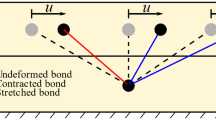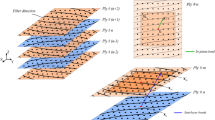Abstract
This study presents the bond-based (BB) peridynamics (PD) with stretch and rotation kinematics for modeling the linear elastic deformation of a composite laminate. The laminate experiences only in-plane and transverse shear deformations and disregards the transverse normal deformation. The PD equilibrium equation for a laminate is derived under the assumption of small deformation and is solved by employing implicit techniques. The in-plane PD forces are expressed by considering the PD bond interactions among the points. The forces arising from the interaction of adjacent layers are expressed by considering a pointwise approach that utilizes the PD differential operator (PDDO) in conjunction with the shear-lag theory. The micro-moduli associated with stretch and rotation are directly related to the constitutive relations between stress and strain components in continuum mechanics. It is restricted to only one constraint on the material constants leading to a fixed value of in-plane shear modulus. The accuracy of this approach is demonstrated by capturing the correct deformation in a laminate for varying layups. Finally, its capability for progressive failure is demonstrated by considering a quasi-isotropic laminate with a pre-existing crack. It employs critical stretch, the critical skew (relative rotation) angle and the critical delamination angle in the bond breakage criteria.
















Similar content being viewed by others
Data Availability
The datasets generated during and/or analyzed during the current study are available from the corresponding author on reasonable request.
References
Silling SA (2000) Reformulation of elasticity theory for discontinuities and long-range forces. J Mech Phys Solids 48:175–209
Silling SA, Epton M, Weckner O, Xu J, Askari A (2007) Peridynamics states and constitutive modeling. J Elast 88:151–184
Oterkus E, Madenci E (2012) Peridynamic analysis of fiber-reinforced composite materials. J Mech Mater Struct 7:45–84
Madenci E, Barut A, Phan N (2021) Bond-based peridynamics with stretch and rotation kinematics for opening and shearing modes of fracture. J Peridyn Nonlocal Model 3:211–254
Zhang Y, Madenci E (2022) A coupled peridynamic and finite element approach in ANSYS framework for fatigue life prediction based on the kinetic theory of fracture. J Peridyn Nonlocal Model 4:51–87
Zhang Y, Madenci E, Zhang Q (2022) ANSYS implementation of a coupled 3D peridynamic and finite element analysis for crack propagation under quasi-static loading. Eng Fract Mech 260:108179
Madenci E, Barut A, Futch M (2016) Peridynamic differential operator and its applications. Comput Methods Appl Mech Eng 304:408–451
Madenci E, Barut A, Dorduncu M (2019) Peridynamic differential operator for numerical analysis. Springer International Publishing, New York
Goland M, Reissner E (1944) The stresses in cemented joints. J Appl Mech 11:A17–A27
Tsai MY, Morton J (1994) An evaluation of analytical and numerical solutions to the single -lap joints. Int J Solids Struct 31:2537–2563
Silling SA, Askari E (2005) A meshfree method based on the peridynamic model of solid mechanics. Comput Struct 83:1526–1535
Ni T, Zaccariotto M, Zhu QZ, Galvanetto U (2019) Static solution of crack propagation problems in peridynamics. Comput Methods Appl Mech Eng 346:126–151
Acknowledgements
This study was performed as part of the ongoing research at the MURI Center for Material Failure Prediction through Peridynamics at the University of Arizona (AFOSR Grant No. FA9550-14-1-0073).
Author information
Authors and Affiliations
Corresponding author
Additional information
Publisher's Note
Springer Nature remains neutral with regard to jurisdictional claims in published maps and institutional affiliations.
Appendices
Appendix A
The correction factor can be determined by calibrating the PD SED associated with fiber deformation against that of CCM by considering a simple strain state of \(\varepsilon_{11} \ne 0,\,\,\varepsilon_{22} = \gamma_{12} = 0\). For this strain state, the classical SED at point, \(x_{1(k)}\) along the fiber can be evaluated as
The PD SED can be evaluated from Eq. (6) as
or
where \(u_{1(j)}\) and \(u_{1(k)}\) denote, respectively, the displacement components at points \(x_{1(j)}\) and \(x_{1(k)}\) in the fiber direction only, and \(N_{(k)}^{f}\) is the number of family members of point, \(x_{1(k)}\) associated with the fiber bonds. The displacement components corresponding to the applied strain state can be expressed as
and
with \(x_{1(k)}\) and \(x_{1(j)}\) denoting the coordinates in the fiber direction with respect to the material coordinate systems, \((x_{1} ,y_{1} )\).
The surface correction for the fiber bonds at point \(x_{1(k)}\) is defined as
Substituting for \(c_{f}\) from Eq. (39) in this equation results in
Hence, the surface correction factor, \(S_{(k)(j)}^{f}\) for a bond between \(x_{1(k)}\) to \(x_{1(j)}\) can be approximated as
Appendix B
The matrices \({\mathbf{H}}_{(k)(j)}^{(k)}\) of order \((3 \times 3K)\) and \({\mathbf{H}}_{(k)(j)}^{(j)}\) of order \((3 \times 3J)\) appearing in Eq. (60) are defined in the form
and
where the matrix of PD function \({\mathbf{G}}_{(k)(j)}^{{(\alpha_{\ell } )}}\) with \((\alpha = k,j)\) is defined as
Appendix C
The relative displacements between layers \(\ell\) and \(u\) due to effective transverse shear strain vector, \({{\varvec{\upgamma}}}^{(\ell ,u)}\), can be expressed in terms of the transverse shear deformation vectors of layers \(\ell\) and \(u\) as
where \({{\varvec{\upgamma}}}^{(\ell )}\) and denote the transverse shear strain vectors of layers \(\ell\) and \(u\), respectively. From the strain–stress relationship, Eq. (97) can be rewritten as
where \({\mathbf{S}}^{(\ell )}\) and \({\mathbf{S}}^{(\ell )}\) represent the compliance matrices relating transverse shear stress vectors to tra \({{\varvec{\upgamma}}}^{(u)}\) nsverse shear strain vectors in layers \(\ell\) and \(u\), respectively. Similarly, \({\mathbf{S}}^{(\ell )}\) denotes the effective compliance matrix relating the effective transverse stress vector to the effective transverse strain vector. It is assumed that \({{\varvec{\uptau}}}^{(\ell ,u)} = {{\varvec{\uptau}}}^{(\ell )} = {{\varvec{\uptau}}}^{(u)}\) throughout the interface between \(\ell\) and \(u\). Hence, replacing \({{\varvec{\uptau}}}^{(\ell )}\) and \({{\varvec{\uptau}}}^{(u)}\) with \({{\varvec{\uptau}}}^{(\ell ,u)}\), Eq. (98) becomes
or after rearranging
Equation (100) leads to the expression for an effective compliance matrix in terms of the compliance matrices of layers \(\ell\) and \(u\) as
Note that \({\mathbf{S}}^{(\ell )} = {\mathbf{C}}^{{(\ell )^{ - 1} }}\) and \({\mathbf{S}}^{(u)} = {\mathbf{C}}^{{(u)^{ - 1} }}\). Hence, in terms of stiffness matrices of layers \(\ell\) and \(u\), The effective compliance matrix, \({\mathbf{S}}^{(\ell ,u)}\), is expressed as
Inverting Eq. (102) yields \(\ell\) the effective stiffness matrix of the interface between layers and \(u\), \({\mathbf{C}}^{(\ell ,u)}\), being expressed in terms of the stiffness matrices of the layers and \(u\) as
where \(t^{(\ell ,u)} = \frac{1}{2}\left( {t^{(\ell )} + t^{(u)} } \right)\). Finally, the resultant interlayer shear stiffness coefficients are computed by
Rights and permissions
Springer Nature or its licensor (e.g. a society or other partner) holds exclusive rights to this article under a publishing agreement with the author(s) or other rightsholder(s); author self-archiving of the accepted manuscript version of this article is solely governed by the terms of such publishing agreement and applicable law.
About this article
Cite this article
Madenci, E., Barut, A. & Phan, N.D. Bond-based peridynamic modeling of fiber-reinforced composite laminates with stretch and rotation kinematics. Engineering with Computers 39, 3561–3576 (2023). https://doi.org/10.1007/s00366-022-01772-w
Received:
Accepted:
Published:
Issue Date:
DOI: https://doi.org/10.1007/s00366-022-01772-w




